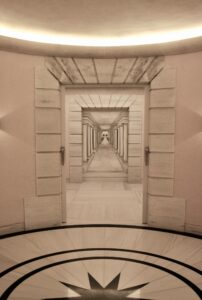21 Oct Perspective Murals
A mural is any piece of artwork painted or applied directly on a wall, ceiling, or other permanent surfaces.
A distinguishing characteristic of mural painting is that the architectural elements of the given space are
harmoniously incorporated into the picture.
Murals date back to 30,000 BC from the earliest paintings in the Chauvet cave France. We usually think
of ancient murals as being the frescoes painted onto wet plaster in Roman times notably from Pompeii.
Invented by Renaissance artists and mathematicians, the use of perspective is an easy way to create the
the impression that a wall goes beyond its material surface.

While it may seem simple, the use of perspective can extend a space beyond its visual boundaries and
play tricks on the eyes i.e Trompe L’eoil, this needs an understanding of vanishing points and where
shadows will fall for the chosen light source.
The first known picture to make use of linear perspective in art was created by Filippo Brunelleschi, but
the artist Masaccio was the first painter who demonstrated the result of the new rules of perspective in art.
Since the renaissance, most artists and certainly muralists are very much aware of the importance of
perspective and the modern-day trompe l’oeil artists employ an understanding of light and shadow to
create 3D illusions.
Richard Bagguley a London based International muralist has been using perspective and trompe l’oeil to
a great effect with sometimes seemingly simple murals to create depth and space where needed.
This mural was painted in the basement used as a spa, gym, and lap pool, it was long and needed a
visual element to create the illusion of depth. Richard Bagguley has carefully used the elements existing
in the space and using perspective and trompe l’oeil given an infinite depth to space.




No Comments